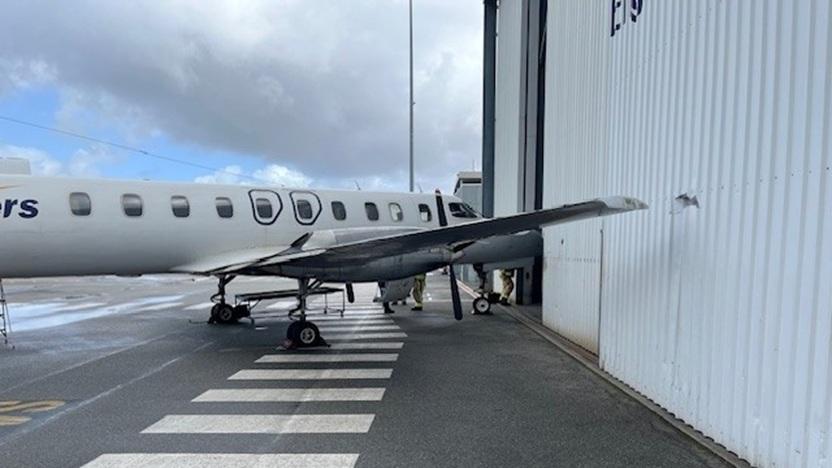


The Australian Transport Safety Bureau (ATSB) has revealed that a brake misjudgment was at the heart of a hangar collision incident at Perth Airport on 12 August 2024, after a recent investigation.
The final ATSB report on the accident, detailed on the official government website, highlights that the pilot of a Fairchild Metro 23 mistakenly believed that the aircraft’s faulty brakes were fully operational during taxi operations after landing.
An ATSB investigation report details that on the morning of 12 August 2024, the Skippers Aviation Fairchild Metro 23 twin-turboprop was being operated on a charter flight from Forrestania, in Western Australia’s Wheatbelt region, to Perth, with two flight crew and four passengers on board.
The first officer was completing supervised line flying and was pilot flying. The captain was pilot monitoring.
During a non-scheduled air transport flight from Forrestania to Perth, the crew of VH-WAJ experienced a complete loss of pressure in the hydraulic system near the top of the planned descent into Perth.
Without the hydraulic system, the flaps, nose wheel steering, and landing gear were not functional, however limited braking was available from a reserve pressure accumulator.
The crew entered a holding pattern to determine the appropriate speed and extra distance required to conduct a flapless landing at Perth, and for the captain to instruct the first officer on how to conduct a manual extension of the landing gear using the hand pump.
ATSB Director Transport Safety Dr Stuart Godley noted that:
“The captain advised air traffic control that a tow vehicle would be required to get the aircraft from the runway to the apron,”
The captain then took over as pilot flying due to the first officer’s limited experience, and conducted an uneventful flapless landing on Perth’s runway 24.
“After landing, the captain could not see or establish direct communication with the requested tow vehicle,” Dr Godley explained. “Finding some brake pressure evident, the captain opted to taxi to the apron.”
The captain considered but elected not to broadcast a PAN PAN call to ATC, instead advising them that a tow vehicle (tug) would be required to tow them from the runway to the apron.
Post touch down, ATC requested the crew’s intentions, and the captain informed them that they would continue the taxi back to the operator’s apron without the assistance of a tug.
As the aircraft approached the hangar, its speed increased due to a slight downhill gradient, and braking was ineffective. In an attempt to avoid collision with the hangar, the captain momentarily used reverse thrust, then shut down the engines and feathered the propellers.

However, the aircraft’s right wingtip collided with the hangar at low speed, before the right propeller made contact. The impact resulted in minor damage to the right propeller and wingtip (Figure 2). All of the occupants disembarked safely, with no injuries to the crew or passengers.
“Aiming to avoid a collision, the captain momentarily used reverse thrust, but then shut down the engines and feathered the propellers before the aircraft’s right wingtip, and then propeller, collided with the hangar at a low speed,” Dr Godley said.
The Fairchild SA227-DC Metroliner (Metro) aircraft came to a rest and all the occupants then disembarked safely.
The investigation report notes that the first officer was a cadet in training with 325 hours total flying experience, and about 34 hours on type.
“Consistent with this minimal experience, the first officer’s ability to contribute to the in-flight emergency management was limited,” Dr Godley explained.
“This meant the captain was required to manage the emergency, effectively taking on both the pilot flying and pilot monitoring roles, and reducing their ability to manage the emergency effectively.”
Investigation reveals that after stopping on the taxiway after landing, the captain mistakenly assumed the brakes were functioning, after noting some braking pressure was evident.
“Unable to locate or contact the tow tug, and influenced by self-imposed time pressure, the captain chose to taxi to the apron, and the minimal available braking capacity meant the crew was unable to stop the aircraft.”
The investigation found the hydraulic failure occurred when a crack in a hydraulic line led to a hydraulic fluid leak.
Dr Godley noted that the investigation highlights the necessity for accurately assessing system functionality following an in-flight failure and the need to follow standard operating procedures.
“Vigilance when assessing aircraft performance and an objective assessment of system status are vital to minimise opportunities for error and avoid relying on potentially misleading indicators,” he said.
“This incident highlights the importance of prioritising procedural compliance in uncertain circumstances, especially when experiencing perceived pressure in non-normal situations.”
The operator confirmed that significant training is conducted with training captains to ensure that pilots’ skills are developed in live operational environments while ensuring safety through operational oversight.
